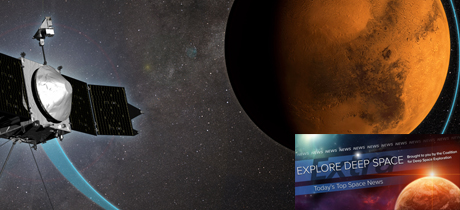In Today’s Deep Space Extra… Some scientists suggest that the human exploration of Mars would be hastened if scientist astronauts worked with surface robots while in orbit around the red planet.
Human Space Exploration
Robotic telepresence could be the best way for humans to explore Mars, scientists say
Geekwire.com (6/22): Human explorers could face less risk at Mars if they staffed an orbiting station and supervised robotic activities on the red planet’s surface, according to a handful of researchers with ties to Arizona State University, Texas based Exinetics and the Jet Propulsion Laboratory.
Whittington: Lunar exploration is a path to ‘something wonderful’
Houston Chronicle (6/23): Op-ed notes NASA’s selection of a dozen men and women for astronaut training on June 7 and urges policy makers to use their skills for human exploration of the moon, an inspiring goal that can fall within their career spans while achievable to the nation financially and technically.
Space Science
Sleep Review (6/23): In order to get sufficient sleep rest astronauts must overcome challenges that include greatly reduced gravity; 90 minute rather than 24 hour cycles of daylight and darkness; and background noise from spacecraft computers and life support systems. Overcoming the obstacles may offer benefits to those on Earth who struggle to get sufficient rest.
Are asteroids leaving the spotlight? No way, say Asteroid Day activists
GeekWire.com (6/24): Activists include Ed Lu, a retired NASA astronaut and co-founder of the B612 Foundation, a Silicon Valley nonprofit committed to identifying asteroids that pose a collision threat to the Earth. The campaign includes Asteroid Day, an annual recognition of the asteroid threat, held each year on June 30, anniversary of the Tunguska explosive impact, an asteroid strike that destroyed half a million acres of forest in Siberia in 1908.
The missing link: Where are medium-size black holes?
Space.com (6/23): Puzzled astronomers suggest fast growth rates may explain why there seem to be many small and large mass black holes in the modern universe but few in between. The findings were published in the journal Nature Astronomy.
Other News
Rideshare demand grows despite development of small launch vehicles
Space News (6/23): Interest in developing small satellites is so far outpacing efforts to develop a new class of launch vehicle dedicated to small sat missions. There’s still plenty of interest in launching small satellites as secondary payloads on larger, established launch vehicles.
Major Space Related Activities for the Week
Major space related activities for the week of June 26-30, 2017
Spacepolicyonline.com (6/24): The U.S. House and Senate are in session this week, with congressional hearings scheduled Thursday on the Trump Administration’s budget request for 2018 and in space propulsion technologies for deep space exploration. Friday is Asteroid Day, a global recognition of the threat to Earth posed by Near Earth Objects, or asteroids and comets that cross the planet’s orbital track.

